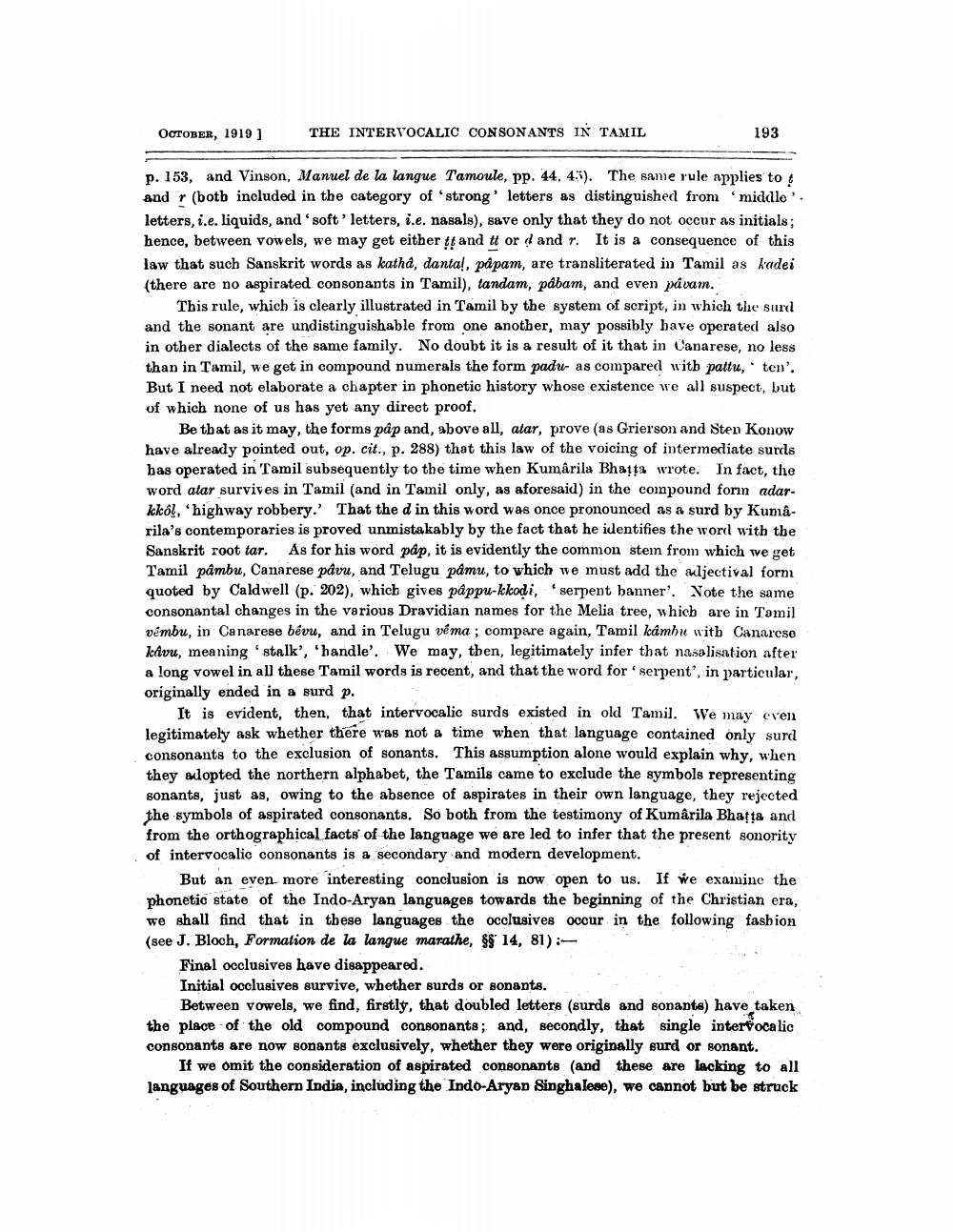________________
OCTOBER, 1919 ]
THE INTERVOCALIC CONSONANTS IN TAMIL
193
p. 153, and Vinson, Manuel de la langue Tamoule, pp. 44, 4.5). The same rule applies to and r (both included in the category of 'strong letters as distinguished from 'middle'. letters, i.e. liquids, and 'soft' letters, i.e. nasals), save only that they do not occur as initials; hence, between vowels, we may get either tt and tt ord and r. It is a consequence of this law that such Sanskrit words as katha, danta!, på pam, are transliterated in Tamil as kadei (there are no aspirated consonants in Tamil), landam, pdbam, and even pávam.
This rule, which is clearly illustrated in Tamil by the system of script, in which the surd and the sonant are undistinguishable from one another, may possibly have operated also in other dialects of the same family. No doubt it is a result of it that in Canarese, no less than in Tamil, we get in compound numerals the form padu- as compared with pattu, ten'. But I need not elaborate a chapter in phonetic history whose existence we all suspect, but of which none of us has yet any direct proof.
Be that as it may, the forms pâp and, above all, atar, prove (as Grierson and Sten Konow have already pointed out, op. cit., p. 288) that this law of the voicing of intermediate surds bas operated in Tamil subsequently to the time when Kumârila Bhata wrote. In fact, the word atar survives in Tamil and in Tamil only, as aforesaid) in the compound for adarkckó!, 'highway robbery.' That the d in this word was once pronounced as a surd by Kumarila's contemporaries is proved unmistakably by the fact that he identifies the word with the Sanskrit root tar. As for his word pap, it is evidently the common stein from which we get Tamil pambu, Canarese pavu, and Telugu pamu, to which we must add the muljectival form quoted by Caldwell (p. 202), which gives pâppu-kkodi, serpent banner'. Note the same consonantal changes in the various Dravidian names for the Melia tree, which are in Tamil vêmbu, in Canarese bévu, and in Telugu vema ; compare again, Tamil kambu with Canarese kavu, meaning 'stalk', 'handle'. We may, then, legitimately infer that nasalisation after a long vowel in all these Tamil words is recent, and that the word for 'serpent', in particular, originally ended in a surd p.
It is evident. then, that intervocalic surds existed in old Tamil. We may even legitimately ask whether there was not a time when that language contained only surd consonants to the exclusion of sonants. This assumption alone would explain why, when they adopted the northern alphabet, the Tamils came to exclude the symbols representing sonants, just as, owing to the absence of aspirates in their own language, they rejected the symbols of aspirated consonants. So both from the testimony of Kumârila Bhatta and from the orthographical facts of the language we are led to infer that the present sonority of intervocalis consonants is a secondary and modern development.
But an even more interesting conclusion is now open to us. If we examine the phonetic state of the Indo-Aryan languages towards the beginning of the Christian era, we shall find that in these languages the occlusives oocur in the following fashion (see J. Bloch, Formation de la langue marathe, $$ 14, 81) :
Final occlusives have disappeared. Initial occlusives survive, whether surds or sonants.
Between vowels, we find, firstly, that doubled letters (surds and sonants) have taken the place of the old compound consonants; and, secondly, that single intertocalic consonants are now sonants exclusively, whether they were originally surd or sonant.
If we omit the consideration of aspirated consonants (and these are lacking to all languages of Southern India, including the Indo-Aryan Singhalese), we cannot but be struck




